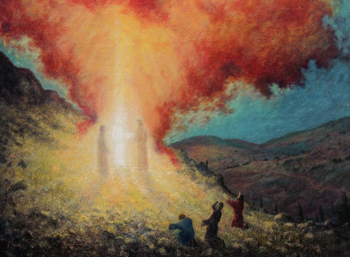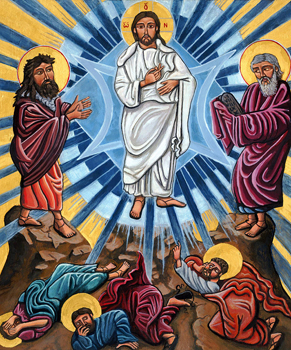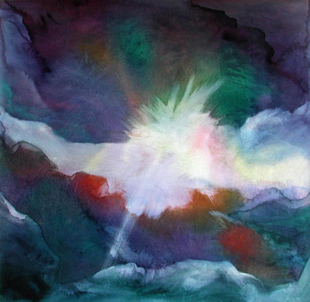For Sunday March 3, 2019
Lectionary Readings (Revised Common Lectionary, Year C)
Exodus 34:29-35
Psalm 99
2 Corinthians 3:12-4:2
Luke 9:28-36, (37-43a)
On the mountaintop, Jesus erupts in sudden light. As his sleepy disciples cower in the grass, two figures appear out of time and space. In solemn tones, they speak of Jerusalem, departure, and accomplishment. The disciples babble in response — "Let's make tents! Let's stay here always! This is good!" A cloud descends, thick and impenetrable. As it envelops the disciples, they fall to their faces, anticipating death. But a Voice addresses them, tender and gentle. The Voice hums with delight, and the disciples, a bit braver now, glance up. They gaze at Jesus — the Shining One — and a Father's pure joy sings with the stars: "This is my Son, my Chosen; listen to him."
In the valley, a boy writhes in the dust. He shrieks and drools, and his eyes — wide-open, feral — sees nothing but darkness. Around him a crowd gathers and swells, eager for spectacle. Scribes jeer, and Jesus’s disciples wring their hands in embarrassment. "Frauds!" someone yells into the night. “Where's your Master? Why has he left you?” "We don't know," the disciples mutter, gesturing vaguely at the mountain. Fear wars with exhaustion as they watch the boy claw at his own face. A voice — strangled, singular — rends the night. "This is my son!" a man cries out as he pushes through the crowd to gather the convulsing boy into his arms. Everyone stares as the father cradles the child against his chest. "Please," he sobs to the stars. "Please. This is my beloved son. Listen to him."
It's Transfiguration Sunday — the apex of the liturgical season we call Epiphany. After weeks of hints and intimations — a star, a dove, an abundance of wine — today we stand in full sunlight, basking in the Beloved's glory. Today we hear the very voice of God.
All three Synoptic Gospels tell the story of the Transfiguration, underscoring its importance to the early church, and all three end their accounts with the narrative of the "demon-possessed" boy whom the disciples can’t heal. It’s an odd pairing, to say the least, and it has always intrigued me. But this year, it commands my attention in a more pressing way, because I know what it’s like to be a parent seeking healing for my child. As I write these words, my son is entering month eighteen of a continuous — and thus far untreatable — post-concussive headache. He hasn’t attended school since October, 2017. Some days, the pain is so bad, he never makes it out of bed. At this point, it’s unclear when or if he’ll finish high school, or be able to return to his much-loved extracurricular activities. So, as much as we love and trust the glorious mountaintops of the Christian story, our family has been living in the valley.
 |
Cue the Transfiguration. Over the centuries, this singular event in Jesus’s life has acccumulated many layers of theological meaning. Growing up, I was taught that the Transfiguration is important because it reveals Christ's divine nature, confirms his Sonship, foreshadows his death, secures his place in the stream of Israel's history, exalts him above the Law (Moses) and the Prophets (Elijah), and prefigures his Resurrection.
Weighty stuff, but here’s the thing: I rarely heard the sick boy's story mentioned in this theologizing. If it was named at all, it was only to underscore the spiritual point that we should not hoard our "mountaintop experiences.” If the bumbling Peter thought it would be cool to pitch a tent on Mount Glory, then the sick boy’s narrative function was to correct him: "No, Peter, that's actually not the divine plan. You can't stay up there in spiritual ecstasy land; the broken world down below needs you.”
I don't have any arguments with Transfiguration theology, but I’ll be honest: it leaves me cold these days. Yes, Jesus revealed his majesty on a mountaintop. Yes, it is essential for us to contemplate that amazing epiphany, and consider what it reveals about Jesus’s identity. But here’s what I'd like to know: how does glory on the mountaintop speak to agony in the valley? What does it mean that the two experiences — fullness and emptiness, ecstasy and despair, light and shadow — share a landscape in this famous Gospel narrative? Aren't there two beloved sons in this story?
I have no idea how the crowd at the base of the mountain experienced the Transfiguration — if they did at all. Did Jesus’s otherworldly glow reach the valley as a tiny pinprick of light? Did the crowd glimpse the ominous cloud that descended over Peter, James, and John? Did they hear a rumble — distant like thunder — when God spoke of his Chosen One? We don’t know.
 |
What we know is that Jesus invited three disciples — only three — up the mountain. What we know is that the remaining nine spent the night in anxious futility, trying to do their Master's work as the stakes rose higher and higher. What we know is that the scene in the valley became tense and ugly as a much-longed-for healing didn’t happen. What we know is that a father and a son suffered, even as the heavens broke open on the mountaintop. What we know is that some people who really needed Jesus that night experienced the ache of his absence — even as a select few basked in his glory.
What if this story — like so many in the Bible — is simply telling us the truth about reality here on earth? Describing what we already know about how life works, but fear to say aloud because we’re so invested in shiny, happy endings?
I tend to interpret the Bible as if its stories apply only to me — me, an individual. My mountaintop experience. My valley. My relationship with my God. But this is both misguided and dangerous. The truth is that my mountain lies right next to your valley. The truth is that your pain does not cancel out my joy. The truth is that it is entirely possible for you to sit in church on Sunday morning and bask in the sweet presence of God's Spirit, while one pew over I cry my eyes out because the ache of His absence feels unbearable.
The same applies if I widen the lens. Do we not — in the privileged West — occupy so many mountains, while our brothers and sisters in other parts of the world dwell in valleys of hunger, warfare, violence, and abuse? Do we not at the same time experience valleys peculiar to “First World” 21st century life — isolation, anxiety, boredom, frenzy — while many who have less by way of material and technological comfort enjoy the mountaintops of more nourishing cultural traditions and communities?
 |
To say this is all unfair is completely beside the point — it is the world we live in, as our Gospel story so honestly illustrates. And so here's the great challenge to the Christian life, the great challenge to the Church: can we speak glory to agony, and agony to glory? Can we hold the mountain and the valley in faithful tension with each other — denying neither, embracing both? Can we do this hard work out of love and compassion for each other, so that no one among us — not the joyous one, not the anguished one, not the beloved one, not the broken one — is ever abandoned or forgotten?
Yes, Jesus came down from the mountain. Yes, he healed the desperately sick boy. But let’s not forget the suffering that came first. Let’s not flatten the story to give our religion neat lines and soft edges. The suffering was real, and it deserves honest witness. After all, the cry of that human father, "Lord, I believe; help my unbelief!" is the most authentic and powerful description of the Christian life I know. He didn't find that testimony on a mountaintop; he forged it in the valley of his son’s pain. Right now, it’s the cry I cling to as I sit at my son’s bedside, praying and waiting.
With Transfiguration Sunday, we come to the end of another liturgical season. Having seen the light of Epiphany, we prepare now for the long shadows of Lent. I don't know what voices will speak to us in the wilderness. Maybe you'll hear glory. Maybe I'll hear agony. Maybe we'll hear each other. Whatever you hear, don't flinch. Don't flee. Don’t assume that one voice must drown out the other. Both voices need to speak. Both voices have much to teach us. So, listen. Listen. Both voices are beloved of a Father.
1. Earl Mott is a painter and poet from Lufkin, Texas. His books include The Unseen Hand, and Text Messages from God.
2. Munir Alawi is a photographer, documentarian, and digital artist, who lives and works in Toronto, Canada.
3. Nicholas Down is a critically acclaimed landscape painter from Dryden, New York.
Image credits: (1) FineArtAmerica.com; (2) FineArtAmerica.com; and (3) AbsoluteArts.com.



